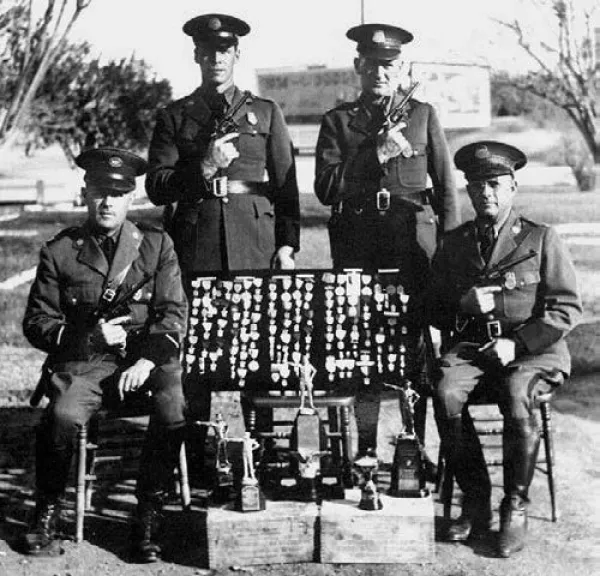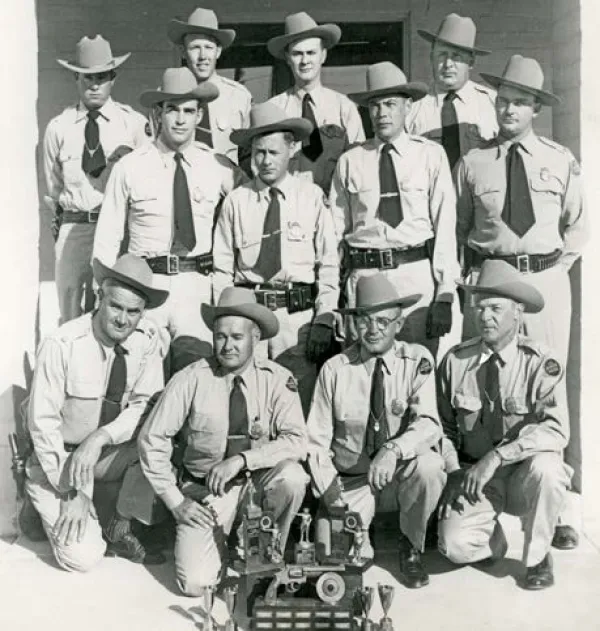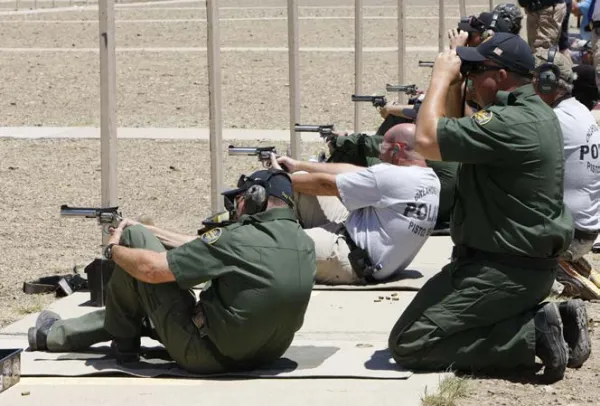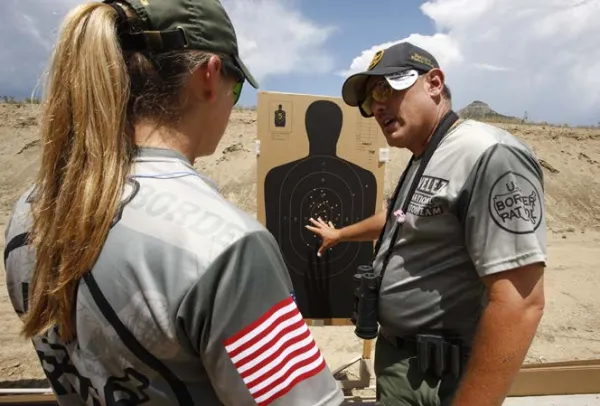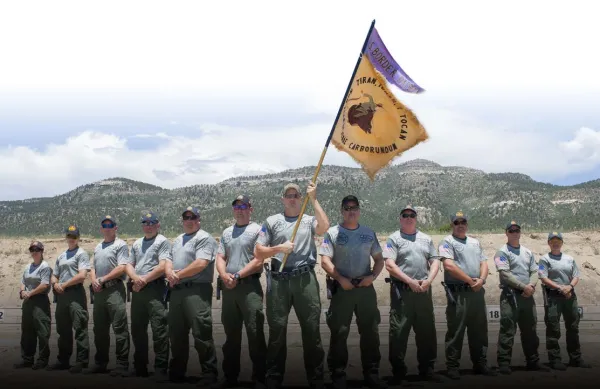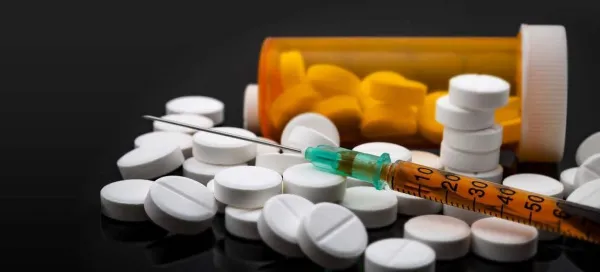
Around the Agency 9-3


Border Patrol target practice at Camp Chigas, El Paso, Texas, during the 1930s. Photo courtesy of CBP History Program collections
Dominant for Decades
Border Patrol Competitive Shooters Spearhead the Sport
By Paul Koscak
Even among the best challengers, taking on the Border Patrol’s handgun team is typically a losing game.
The Border Patrol has produced the nation’s most renowned pistol shooters since the early 20th century. They’ve triumphed at myriad local and regional contests, earned multiple first-place prizes at national competitions and even hold international records.
“We’ve won so many events, I can’t even count them,” said Border Patrol Agent Robert Vadasz, consistently one of the world’s top three shooters, who entered the sport in 2004 and was featured on the cover of American Rifleman, the National Rifle Association’s signature magazine.
In November 2016, Vadasz set a new record as the world’s best metallic pistol shooter by winning the metallic division at the NRA’s World Action Pistol Championship in New Zealand. It’s a significant feat because metallic competitors use a non-modified pistol with only standard metal sights. Earlier that year in May, he placed second in the metallic division at the NRA’s U.S. National Championship Bianchi Cup in Missouri.
Considered the best marksmen in pistol-shooting sports, the Border Patrol’s 10-member national pistol team with their monogrammed black hats are noticed when arriving at an event. “We’re the most recognized team within the competitive shooting community,” Vadasz said.
Winning legacy
Competitive shooting and Border Patrol culture go hand-in-hand with a legacy that reaches back almost to 1924, when the unit was formed. Back then, sharpshooting agents competed in local “bull’s-eye” contests and national matches at Camp Perry, Ohio.
Agent Charles Askins emerged as the Border Patrol’s top shot and the 1937 national pistol champion.
“We cleaned up locally,” Askins later wrote in an article. “We were the champs of Texas and felt pretty cocky, so we went to the national matches.” Askins also helped create the Border Patrol’s first firearms training program and agent qualification standards.
More champion agents—Elmer Hilden, Joe White, Bill Toney and others—followed during the 1950s and 1960s, earning several individual and team national titles. One of those agents, Harland Carter, became the Border Patrol chief in 1950 and served as the National Rifle Association’s executive vice president from 1977 to 1985. His badge and pistol are on display at the NRA’s National Firearms Museum in Fairfax, Virginia.
In 1966, the Border Patrol’s pistol team switched to a new format: Police Pistol Combat, or PPC. Developed by the NRA and FBI, PPC is a fast-paced, timed course mimicking law enforcement action where contestants shoot from barricades and from different positions.
Local, state and regional tournaments and the NRA’s annual National Police Shooting Championships in Albuquerque, New Mexico, use this standard format. Competitions are open only to civilian and military law enforcers. As with the earlier bull’s-eye events, the Border Patrol’s national pistol team has dominated the contests. Since 1966, 10 agents won the national championships—one agent won three times, another won twice and Vadasz won the title eight times.
Aiming for the top
Becoming a title holder begins at a local contest usually sponsored by a sheriff’s office, police department, state police or other law enforcement agency. A Border Patrol sector typically fields a team where agents score individually and as a group, explained Art Velez, the national pistol team’s captain. Agents who score the most points up to 1,500 move on to the NRAsponsored regional matches to vie against the best shooters from several counties or an entire state. They may also qualify to join the Border Patrol’s national team during its annual recruiting.
The team travels to five NRA national tournaments, challenging the nation’s best law enforcement shooters. Agents winning national awards can enter shooting’s pinnacle event—the Bianchi Cup, the NRA’s Action Pistol Championship. Named for police officer John Bianchi, this three-day event held every two years is not just for law enforcers but open to all qualifying shooters striving to be the world’s ultimate pistol shooter. Like the Olympics, the competition is held at different international locations.
Using the PPC format, local, regional or national bouts are the same—five matches where contestants earn points firing at a paper target from different distances. About 2 feet in length, the oval black target has four white rings and a bull’s-eye, positioned within a large human torso outline. Advancing toward the target’s center, the space between each ring is worth seven, eight and nine points respectively. The bull’s-eye, 10 points. Velez described the demanding requirements.
- Match one—20 seconds to fire 12 rounds at the target from 7 yards, then again at 15 yards.
- Match two—90 seconds to fire six shots from each position: kneeling and firing with the right and left hand while standing behind a barricade from 25 yards. (The barricade is a wood plank about a foot wide and several feet high.)
- Match three—2 minutes and 45 seconds to fire six rounds from each position: sitting, prone and firing with the right and left hand while standing behind a barricade from 50 yards.
- Match four—35 seconds to fire 12 rounds from 25 yards while standing, performed twice.
- Match five—60 rounds fired in four stages:
- Stage A—20 seconds to fire 12 rounds from 7 yards.
- Stage B—90 seconds to fire 18 rounds kneeling behind a barricade and also standing and firing from the left and right side of a barricade from 25 yards.
- Stage C—2 minutes and 45 seconds to fire 24 rounds while sitting, prone and from the left and right side of a barricade from 50 yards.
- Stage D—12 seconds to fire six rounds without any support to steady the pistol from 25 yards.
Matches must be accomplished with different pistols, all adding up to 150 rounds to earn a potential 1,500 points, Velez said. They vary from the service weapon to revolvers to semi-automatics. Some are “stock” pistols, meaning right out of the box while others are modified as per NRA rules.
Two- and four-shooter teams compete as well. “One fires while the other coaches,” Velez said. “Then the one firing becomes the coach.” Coaches will point out shortcomings to assist the shooter, such as aiming too high or too low or using too much pressure to steady the pistol against the barricade. Four-shooter teams perform the same task except with two coaches and two shooters.
“Imagine trying to hit a 1 1/2-inch circle at 50 yards,” said Velez, describing the toughest bull’s-eye shot of all.
The right stuff
So what does it take to be the best?
Accuracy, alignment and trigger control are the pillars of competitive shooting, Velez pointed out. Accuracy is the skill to have the round go exactly where you want it. Alignment means the pistol’s aiming sights are properly set. Trigger control separates the winners from everyone else. “Ninety percent is trigger control,” Velez insisted. “You’re not pulling. It’s a steady pressure in all one movement. And you don’t stop.” Uneven pressure can lift the pistol’s barrel just enough to miss the mark, he said.
“Once the shot is made, don’t dwell on it,” advised Shawn Becker, a team member and supervisory Border Patrol agent who enjoys mentoring new shooters. “Look to the next shot.” Thinking about it is a distraction and wastes valuable seconds, he explained. “Concentrate on what to do next,” Becker said. “Don’t dwell on the score.”
Top shooters not only have good vision, they also visualize, said world record holder Robert Vadasz. “They see wind, humidity, elevation,” factors that affect a bullet’s path. “Some days, I can see the bullet traveling down range.” Muscle memory, to precisely perform mechanical tasks such as aiming or trigger-pulling without thinking, is also crucial and it only comes with repetition. “I’ve fired over 100,000 rounds,” said Vadasz, describing his dedication to practicing.
Keeping equipment in perfect condition is critical. Guns, he said, are machines that can break down. “A bad round or a sliver of metal is all it takes” to lose, he said.
Proper mindset is essential: Have a winning attitude and expect success, but be ready to accept failure and to learn from your mistakes, Vadasz stressed. “I’ve lost a lot more than I ever won,” he added.
Then there’s commitment. Along with the mental drain from the events, the team is frequently on the road from April to September which takes a toll. “You’ve got to be dedicated and willing to persevere,” said Ben Morrow, a Border Patrol intelligence agent and former team captain. “Not everything will work out.”
At the same time, there’s plenty of support, mentoring and camaraderie. “There’s no ego” among team members, Morrow said. “We reach out to assist.” He said members will let new members borrow guns or ammunition to offset sizable startup expenses.
He told a story of the time his pistol failed to work, keeping him from entering a local match in Long Beach, California. “I knew I was out,” recalled Morrow, a 20-year Border Patrol veteran who’s won several national titles. So one of his competitors, a Los Angeles police officer, nobly offered to fix it. “He had all the tools and experience repairing guns,” he said. The gun was repaired, Morrow was back in the game and ended up beating the officer. “That’s the kind of camaraderie we have.”
Just ask Acting Border Patrol Supervisor Tracy Wong.
Nine years into her career and a contender in many local matches in San Diego, Wong is enjoying her second competitive shooting season. “Everyone is so open to helping you,” she said. “It really makes a difference.” Wong is one of four women serving as national team alternates while enrolled in the marksmanship development program, where she’s paired with a mentor at shooting events. “You get to shoot an entire week at a tournament,” Wong said. “That’s where my skills and confidence greatly improved. At the nationals, my score went up 100 points. It’s a great honor to be on the team.”
Morrow also promotes that type of unity by coaching children in the BB gun matches that are part of state shooting events. Children from 5 to 13 years old compete while learning about gun safety. “This teaches sportsmanship,” he said. “At the end, we have a banquet. It’s fun to give back.” Like their adult counterparts, the youths have their own NRA sponsored championships.
Being on the team, Morrow said, means being part of an exclusive history. “I think about our legacy all the time,” he admitted. “We all know better shooters came before us and we don’t want to let them down. I’m going to compete until I can’t hit the target.”
Spike in opioid seizures prompts precautions from commissioner
Acting Commissioner Kevin K. McAleenan reached out to CBP’s frontline force to ensure they remain safe when encountering opioids and fentanyl. CBP’s law enforcers are more likely to come across those drugs because seizures have tripled since fiscal year 2015.
“Your safety always comes first,” he said in an Aug. 15 message that outlines the precautions and treatments officers and agents, along with laboratory workers, emergency responders and all law enforcement, need to be aware of to protect themselves and the citizens they serve.
Opioids and fentanyl are epidemics sweeping the nation and the leading killer of people less than 50 years old. Fentanyl, a pain medication, is powerful—up to 100 times more potent than morphine. Overdoses point to the way fentanyl is made in illegal laboratories, reports the Centers for Disease Control and Prevention.
Decreased consciousness, slow breathing and pinpoint pupils are signs of fentanyl and opioid intoxication, according to the Drug Enforcement Administration. The DEA also lists rapid heart rate, nausea, vomiting, and dizziness, among the other symptoms.
For overdoses, fentanyl can be reversed by Naloxone, a prescription medicine with the brand name Narcan. Naloxone is extremely safe and should be used when an opioid overdose is suspected and then bring the victim to a hospital, as stated by the National Institute on Drug Abuse.
To stay safe, frontline personnel should approach fentanyl the way they would approach all chemicals of concern or unknown substances. Basic personal protective equipment with nitrile gloves, a properly fitted n-95 or p-100 mask, and OSHA approved eye-protection will safely protect against fentanyl exposure.
Throughout all the protocols dealing with opioids, one precaution is constantly stressed—hand washing with copious amounts of soap and water. Wash after handling opioids; wash after every shift; and wash before eating, drinking or smoking. However, don’t use alcohol-based hand sanitizers because they allow the skin to absorb the drugs, advises the DEA.


